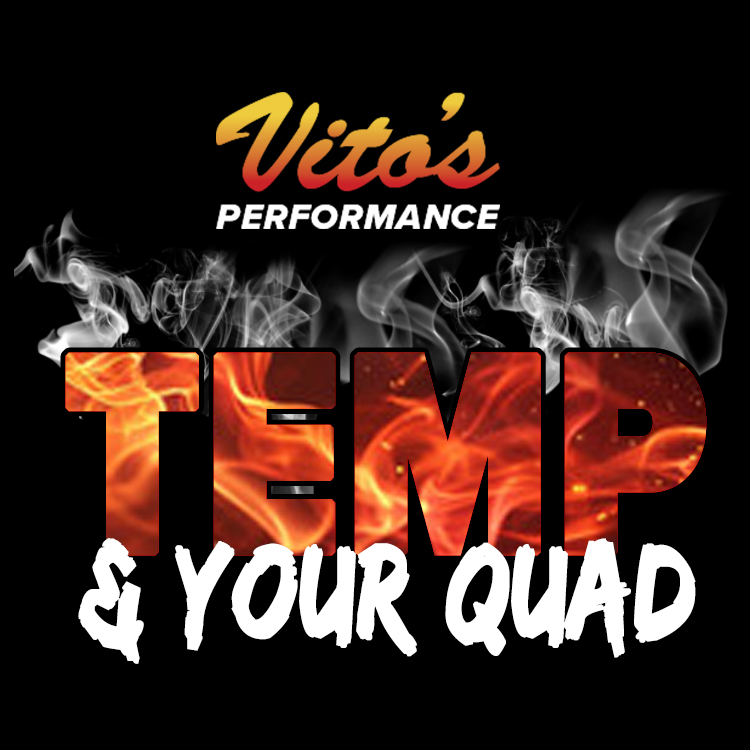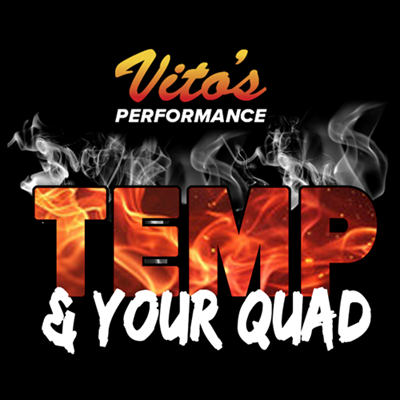How Temperature Affects Your Quad’s Engine
JULY 16, 2024

During the summer, when your quad is likely to hit the dirt more often, overheating can be an issue. In colder months, lubrication and starting ATVs can cause performance issues. In these ways and others, temperatures can significantly affect not only the performance, but also the longevity of your quad especially if issues caused by temperature affect the motor.
Fortunately, there are precautions you can take, as well as solutions you can perform, to keep your quad running and prevent effects to the engine.
Let’s look first at how to spot and prevent issues first in hot temps, then in cold temps. Stay cool (or warm) out there!
Hot Temps and Your Quad’s Engine
Being aware of ATV overheating symptoms is also critical in ensuring that you stop riding right away to avoid major engine damage. The clearest indicator of an ATV overheating is by spotting it with an instrument cluster with an overheat warning. But not all ATV overheating symptoms are this clear to understand.
The first sign will likely be a burning coolant smell and steam coming from the radiator. Try to stop safely. If you continue to ride, the engine will begin ticking and the piston can expand and seize.
Signs your engine is overheating include:
- Power loss
- Leaking or dripping fluid
- Your vehicle’s case is particularly hot
- The engine is making a ticking noise, indicating oil burning off
- A strange smell is coming from the coolant
- Steam is visible
An ATV might overheat and display the symptoms above for many reasons. Here’s a plan of action if you predict your quad may be overheating:
- First, stop riding. Even if there is nothing wrong with the machine, hot climates can overwhelm the cooling system, so you may want to sit out the ride.
- Check the radiator. Remove any dirt or clogs from the radiator to keep fluids cool.
- Check the coolant or radiator fluid, as well as the radiator fan and hose. Also check the cap to ensure that it and the gasket are creating a strong seal.
- Monitor the ATV’s water pump or impeller for leaks.
Prevention tips for overheating include making sure to:
- Keep radiator clean — Remove the detachable screen and wash it with a hose or pressure washer. Then use a hose to clean the radiator fins. Be careful around the fins, which have to stay in the same shape to cool the machine.
- Regularly maintain the coolant — Use a coolant tester and follow manufacturer recommendations on how often to flush and change the coolant every few months.
- Upgrade parts if needed — Add a few aftermarket items to improve your ATV’s cooling abilities, such as an electric radiator fan, an aftermarket water pump and impeller, or a high-pressure radiator cap that can help keep your engine cool even if you’re low on coolant.
- Test the thermostat regularly — To check if it’s working, hang the thermometer in a pan of heating water and watch to ensure the thermostat opens fully at 10 to 15 degrees above its rated temperature.
- Store your quad properly — Keep it in a cool, dry place (like a shed or a garage) or use a heavy-duty ATV cover outside and regularly check its fuel levels and its tires.
Overheating isn’t the only way hot temperatures can affect your engine. Engine performance is also affected by:
- Lubrication: Oil can become too thin, reducing its effectiveness in lubricating engine components and increasing wear.
- Fuel Efficiency: Air density can be affected, leading to a leaner air-fuel mixture which can reduce engine performance and efficiency.
- Components and systemic issues: Electrical Components: Wiring, connectors, and electronic control units are vulnerable to heat and battery life.
- Cooling efficiency problems: High ambient temperatures put additional strain on the cooling system and your engine. Coolant evaporation in excessive heat can cause coolant to evaporate faster.
- Metal expansion: Clearances and tolerances will be affected, potentially leading to issues such as piston seizure or increased friction.
Cold Temps and Your Quad’s Engine
Engine performance in cold temperatures is affected by thicker oil, battery performance, and fuel atomization.
Here are some signs and symptoms to look out for:
- Difficult Starting: Cold weather can make the oil thicker, which can increase the resistance and make it harder for the engine to turn over.
- Rough Idle: If the engine does start, it may idle roughly until it warms up because cold temperatures can affect the fuel and air mixture, leading to incomplete combustion.
- Reduced Battery Performance: Cold weather can reduce the battery's efficiency, leading to slower cranking speeds and less power available to start the engine.
- Thicker Fluids: Engine oil and other fluids can become thicker in cold weather, increasing the engine's resistance and making it work harder to move internal components.
- Fuel Issues: Cold temperatures can cause condensation in the fuel tank, leading to water in the fuel. This can cause starting problems or rough running.
- Carburetor/Ignition Problems: For carbureted engines, cold weather can lead to carburetor icing, where ice forms in the carburetor and disrupts the air/fuel mixture. In general, ignition systems can also be less effective in cold conditions.
If you want to avoid issues to your motor, we suggest you make these maintenance choices when the weather gets cold:
- Keep your battery fully charged using a battery tender when the ATV is not in use.
- Use the correct viscosity of engine oil for cold weather.
- Use fuel stabilizers and additives designed to prevent condensation and fuel line freeze-up.
- Allow the engine to warm up for a few minutes before riding to ensure the oil circulates properly.
- If possible, store your ATV in a garage or shed to keep it out of the cold.
- Adjust the carburetor properly and consider resetting it if necessary. By taking these steps to winterize your quad , you can better prepare and maintain your engine for optimal performance in cold conditions.
POWER UP
Since 1998, Vito’s Performance has been supplying the world with top-quality and hard-to-find ATV parts for builders and enthusiasts alike. We specialize in the Yamaha Banshee and the Yamaha Blaster, and carry parts for all Yamaha Raptors, the Yamaha Warrior, Honda 300ex and 400ex, and the Honda TRX450r. For assistance with all performance products, contact Vito’s Performance online or call (248) 969-9168.




